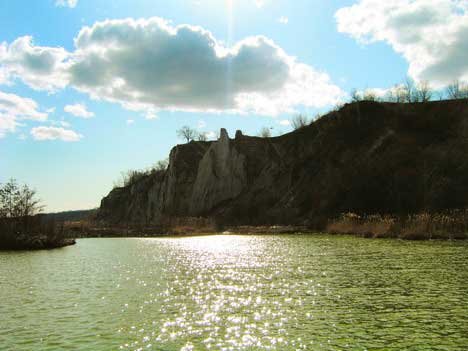
East End – The Don
All our city’s green spaces deserve to be hugged. They’re all lovable. The Humber is beautiful in a pastoral way. The Rouge, a natural heritage site, is simply breathtaking. But the Don Valley is something else. Its beauty is its indomitable spirit. Despite the ravages of decades of industrialization and a six-lane highway running a concrete ribbon through it, the Don’s still where we live and play every day. Most see death in this valley, but mystery and intrigue are everywhere – in the rusted-out bridges, reclaimed marshlands, twisted and mangled trees and abandoned rail lines crossing this way and that. The Don inspires that out-of-this-world feeling. It starts the moment you dip down from street level at Eldon Garnet’s Time: And A Clock at Queen and that first wind hits your back. When the light is just right, the hydro towers sticking up over the horizon look like giant men from space. The Don’s the perfect getaway. The secret hiding places are many: the mountain-bike-chewed paths of Crothers’ Woods, long-forgotten logger’s run, where Leslie stops at Eglinton, and majestic Sherwood Park further north. Add the horse stables at Sunnybrook Park and glorious Edwards Gardens to your destinations and you’re all set for a day trip. But wait. No exploration of the Don Valley would be complete without a traipse through Moatfield Farm Park, nestled between Leslie and Don Mills just south of the 401. Sounds like a great idea.

Paul Terefenko
West End – The Humber
The Don may get cred for its epic struggle against industrialism, but it’s the Humber that marks the centuries and soothes city angst.
Every time you come out of the subway tunnel at Jane, you’re struck by the stunning beauty of Etienne Brûlé Park, named after the first European explorer to reach the river’s mouth in 1615.
But this waterway’s history goes back 10,000 years native people used it as an ancient hunting and camping site, and tools 4,000 years old have been found on its banks.
Back in 1793, pre-Toronto, our first industrial building was a mill on the river that supplied the wood for Fort York. The third mill on the site is now a spa/hotel, and while that’s a bit irritating, the whole valley could have gone the way of industrial overuse, pollution and destruction.
So where much of the Don watershed was turned over to factories, the Humber was always residential – a little more intimate and natural. After Hurricane Hazel, the Humber was designated perpetual parkland.
It beats the Don, too, on the sheer number of trails the east-end green space has 20 kilometres of them, and the mighty Humber, 32. Sixty species of fish swim its currents, and its marshes are nesting grounds for the Great Blue Heron and American Coot.
On a bike, follow the riverbed seamlessly across the Humber Bridge, a breathtaking arch that looks like a bleached rib cage, to the Martin Goodman Trail. Birdwatching, trails, firepits, boats, skating – trust this refuge to work off urban claustrophobia.












